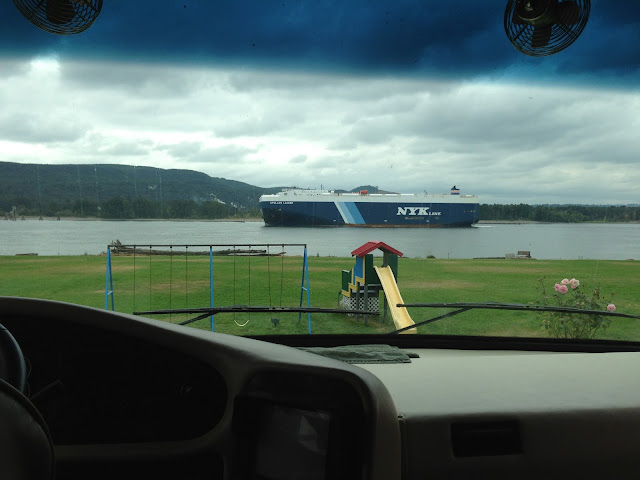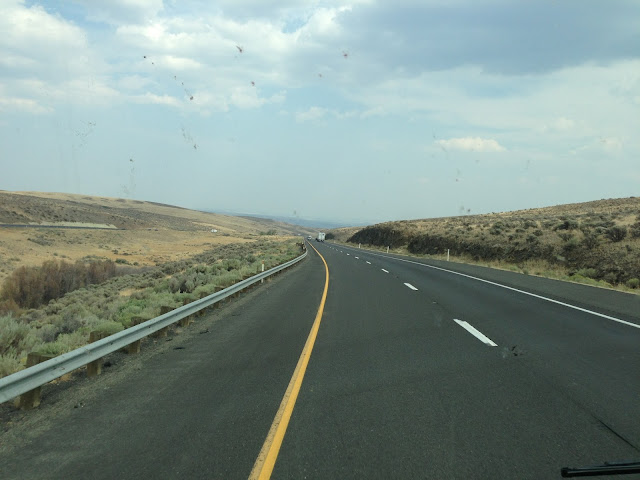 |
| We scored a good front row bus seat on the highly acclaimed tour of the Manhattan Project B Reactor Tour (Richland, WA). |
 |
| Nuclear reactor site |
 |
| Hanford is about half the size of Rhode Island and located in the south east corner of Washington. The B Reactor is in the center (see the stack) and a shutdown "cocooned" reactor is on the right. |
 |
| This is an old stone fruit warehouse on the now government-owned area |
 |
| A cocooned reactor that will eventually be dismantled |
 |
| The Reactor Pile in the Manhattan Project B Reactor. It is nonfunctional now, but it was the longest running and most productive plutonium development reactor in the world. |
 |
| The history of the Reactor is amazing - including all of the old safety and measurement instruments |
 |
| The scientists and electricians that ran the B Reactor developed special instrument prototypes to monitor the systems. |
 |
| The reator worked about five to six weeks at a time. Some of these pictures show 1940's technology and 1960's technology. |
 |
| The train used to move the spent fuel rods from one of the nine reactors on the site to one of the three processing plants. These are Department of Energy locomotives. |
 |
| A view from the RV of the boat traffic on the Columbia River in Woodland Washington. |
 |
| Local frog |
 |
| Sweet Maxie soaking up the sun and sights |
 |
| Cool riverboat in Woodland, WA |
 |
| Moon light over the Columbia River in Woodland, WA |
 |
| Running in Chehalis, WA |
 |
| Maxie trying out his new ride - he does pretty well in it for long night time walks |
 |
| Max smelling the "Aroma of Tacoma" (Seawater, Paper Mill, Shipyard, and Sewage Treatment Plant). He gets a ride in the front seat these days. |
 |
| Bark machine at the Port of Tacoma |
 |
| Local lumber mill in Tacoma |
 |
| Huge scrap metal pile at the Port of Tacoma |
 |
| Boat hull forms at the shipyard in Tacoma |
 |
| Bark plant at the port |
 |
| Log pens at the Port of Tacoma |
 |
| Tacoma Rail |
 |
| Tacoma |
 |
| Train coming through the crossing |
 |
| Toward Snoqualmie Mountain on the way to Eastern WA |
 |
| Once over the mountains, the landscape changes from lush green Western WA to the dry hot desert of Eastern WA |
 |
| The Columbia River |
 |
| Downtown Richland, WA |
 |
| Richland, WA |
 |
| Richland, WA campground |
 |
| Beginning the Manhattan Project Reactor B Tour - a video to watch before we board the bus |
 |
| Our tour guide talking about the Reactor and the importance to the war effort |
 |
| "Hundreds of lights blinking and flashing and blinking and...." |
 |
| 2004 process tube water flow and pressure gauges - during production there were scientists measuring these at all times |
 |
| 40's and 60's technology side by side - used to measure the temperature of each of the 2004 process tubes. |
 |
| A model of the way the graphite blocks were stacked to hold the process tubes. |
 |
| Insulated and shielded cases to transport the spent fuel rods to the process plant - called "casks" |
 |
| Rattle Snake Mountain - a little over 3,000 feet high |
 |
| A huge bear statue in Richland, WA |
 |
| It is a desert. |













































No comments:
Post a Comment